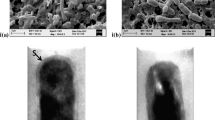Abstract
Previous studies have demonstrated that the ability of lactobacilli to attach to and colonize uroepithelial surfaces is an important characteristic that enhances interference against uropathogenic bacteria. This adherence capacity was found to vary amongst lactobacillus strains and with the type of growth medium used to culture the organisms. The present study was undertaken to examine further the effect of culture media and growth phase on lactobacillus adherence to uroepithelial cells in vitro. In addition, a freeze substitution technique was developed to examine the morphology of strainsLactobacillus casei ssrhamnosus RC-17,L. casei GR-1, andL. acidophilus T-13 in relation to growth conditions and adhesion. A growth curve was plotted for strain GR-1, and adherence was found to be lowest for bacteria in early log phase (39 bacteria per uroepithelial cell) and highest in stationary phase (59 bacteria per uroepithelial cell). Strains RC-17 and GR-1 attached in high numbers to uroepithelial cells, whereas T-13 was poorly adherent. The latter formed a long, relatively dense, fibrous capsule after growth in brain heart infusion yeast extract agar, unlike strains GR-1 and RC-17, which formed a short, tightly bound, electron-dense capsule which surrounded the cells in a radial fashion. Growth of RC-17 in batch cultures of human urine, with and without addition of carbohydrates, resulted in formation of an irregular, fibrous extracellular matrix. These experiments illustrate that growth phase and culture conditions affect the extracellular structure of lactobacilli and also affect the adherence capacity of these bacteria. Structural changes mediated by availability of nutrients may partly explain why lactobacilli vary between species and between hosts in their colonization of the urogenital tract.
Similar content being viewed by others
Literature Cited
Chan R, Acres SD, Costerton JW (1984) Morphological examination of cell surface structures of enterotoxigenic strains ofEscherichia coli. Can J Microbiol 30:451–460
Chan RCY, Bruce AW, Reid G (1984) Adherence of cervical, vaginal and distal urethral normal microbial flora to human uroepithelial cells and the inhibition of adherence of gram-negative uropathogens by competitive exclusion. J Urol 131:596–601
Chan RCY, Reid G, Irvin RT, Bruce AW, Costerton JW (1985) Competitive exclusion of uropathogens from human uroepithelial cells byLactobacillus whole cells and cell wall fragments. Infect Immun 47:84–89
Cook RL, Tannock G, Meech R (1984) The microflora of the vagina. Proceedings of the University of Otago Medical School, Dunedin, New Zealand 62:72–74
Costerton JW, Irvin RT, Cheng K-J (1981) The role of bacterial surface structures in pathogenesis. CRC Rev 8:303–338
Duguid JP, Clegg S, Wilson MI (1979) The fimbrial and non-fimbrial hemagglutinins ofEscherichia coli. J Med Microbiol 12:213–227
Graham LL, Costerton JW (1986) The role of bacterial exopolysaccharides in the adhesion of indigenous urethral flora to human uroepithelium. Proceedings of the 36th Annual Meeting of the Canadian Society of Microbiologists, Toronto, Canada, June 8–11. #IN 9p, p 91
Klemm P (1985) Fimbrial adhesins ofEscherichia coli. Rev Infect Dis 7:321–340
Knox KW (1963) Isolation of group specific products ofLactobacillus casei andL. casei var.rhamnosus. J Gen Microbiol 31:59–72
Knox KW, Wicken AJ (1984) Environmentally induced changes in the surfaces of oral streptococci and lactobacilli. Proc. ASM Workshop, Molecular basis of oral microbial adhesion, Philadelphia, PA, June 5–8, pp 212–219
Markham JL, Knox KW, Wicken AJ, Hewett MJ (1975) Formation of extracellular lipoteichoic acid by oral streptococci and lactobacilli. Infect Immun 12:378–386
Ohashi H (1982) Clinical and bacteriological study on microbial flora in the vagina. Kansenshogaku Zasshi 56:647–654
Reid G, Brooks HJL (1984) In vitro attachment ofE. coli to human epithelial cells. NZ Med J 97:439–442
Reid G, Brooks HJL (1985) A fluorescent antibody staining technique to detect bacterial adherence to urinary tract epithelial cells. Stain Technol 60:211–217
Reid G, Sobel JD (1987) Bacterial adherence in the pathogenesis of urinary tract infections: a review. Rev Infect Dis 9:470–487
Reid G, Brooks HJL, Bacon DF (1983) In vitro attachment ofEscherichia coli to human uroepithelial cells: variation in receptivity during the menstrual cycle and pregnancy. J Infect Dis 148:412–421
Reid G, Chan RCY, Bruce AW, Costerton JW (1985) Prevention of urinary tract infection in rats with an indigenousLactobacillus casei strain. Infect Immun 49:320–324
Reid G, Zorzitto ML, Bruce AW, Jewett MAS, Chan RCY, Costerton JW (1984) Pathogenesis of urinary tract infection in the elderly: the role of bacterial adherence to uroepithelial cells. Curr Microbiol 11:67–72
Reid G, Cook RL, Angotti R, Adre JK, Bruce AW (1987) Bacterial interference and the role ofLactobacillus spp. in preventing recurrent urinary tract infection. In: Murakami K, Kitagawa T, Yabuta, K, Sakai T (eds), Recent advances in pediatric nephrology. Amsterdam, Holland: Excerpta Medica ICS 733:265–270
Reid G, Cook RL, Bruce AW (1987) Examination of strains of lactobacilli for properties which may influence bacterial interference in the urinary tract. J Urol 138:330–335
Rogosa M (1970) Characters used in the classification of lactobacilli. Int J Syst Bacteriol 20:519–533
Seddon JM, Bruce AW, Chadwick P, Carter D (1976) Introital bacterial flora-effect of increased frequency of micturition. Br J Urol 48:211–218
Sharpe E (1981) The genus Lactobacillus. In: The prokaryotes, a handbook on habitats, isolation, and identification of bacteria. New York: Springer Verlag, vol 2, chap 131, pp 1654–1679
Wheater DM (1955) The characteristics ofLactobacillus plantarum, L. helveticus andL. casei. J Gen Microbiol 12:133–139
Wicken AJ, Knox KW (1984) Variable nature of the bacterial cell surface. Aust J Biol Sci 37:315–322
Wicken AJ, Ayres A, Campbell LK, Knox KW (1983) Effect of growth conditions on production of rhamnose-containing cell wall and capsular polysaccharides by strains ofLactobacillus casei subsp.rhamnosus. J Bacteriol 153:84–92
Author information
Authors and Affiliations
Rights and permissions
About this article
Cite this article
Cook, R.L., Harris, R.J. & Reid, G. Effect of culture media and growth phase on the morphology of lactobacilli and on their ability to adhere to epithelial cells. Current Microbiology 17, 159–166 (1988). https://doi.org/10.1007/BF01573472
Issue Date:
DOI: https://doi.org/10.1007/BF01573472




